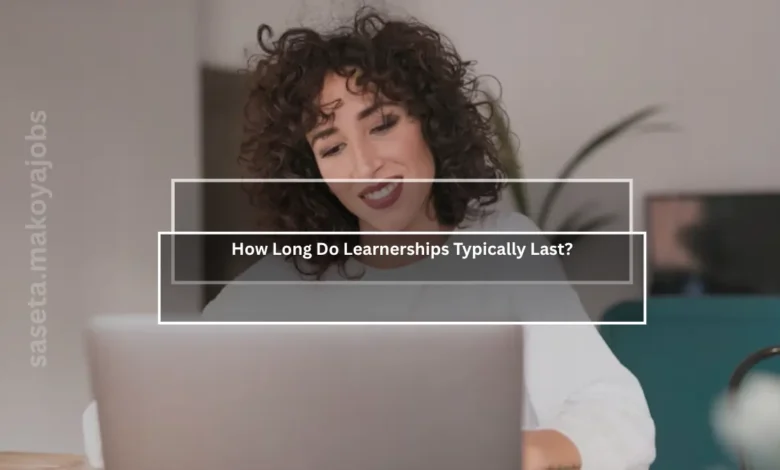How Long Do Learnerships Typically Last? A Practical, Human-Centered Guide

Learn how long learnerships typically last, what to expect, and how they can jump-start your career. helpful guide for your next steps.
Thinking about starting a learnership? Whether you’re exploring new skills, building a career, or transitioning into a different field, understanding the duration of a learnership is a key first step. This guide breaks it down clearly—without jargon or fluff—so you can plan your future with confidence.
What Is a Learnership and What Does “Duration” Really Mean?
A learnership is a structured, workplace-based education and training program in South Africa. These programs combine hands-on experience with practical learning and lead to a recognized qualification on the National Qualifications Framework (NQF).
The duration refers to the full length of time needed to complete all training—both in the classroom and on the job. Knowing the typical duration helps you set realistic expectations and manage your time, budget, and career goals.
Why Duration Matters: Plan with Purpose
- Time Investment: Timing affects when you’ll enter the job market or advance your studies.
- Financial Planning: Whether stipends or out-of-pocket expenses, knowing how long helps your budgeting.
- Career Clarity: Some programs focus on fast entry, others on deeper specialization.
- Commitment Ready: You’ll know whether what you’re signing up for is short, medium, or long term.
Typical Learnership Durations by Level
Here’s how long different learnerships often last based on qualifications and skills level:
| NQF Level | Typical Duration | Description |
|---|---|---|
| Levels 2–4 | 6 to 12 months | Entry-level skills; often basic workplace training |
| Levels 5–6 | 12 to 18 months | More technical or supervisory learning |
| Levels 7–8 | 18 to 24 months | Complex, high-level skills or management training |
| Post-Grad or Advanced | Up to 36 months | Extended roles, often requiring deep specialization |
Note: The duration can vary by training provider, industry sector, and type of learnership.
What Influences the Length of a Learnership?
1. NQF Level and Complexity
- Lower-level programmes—like basic administration or general security—typically run between 6–12 months.
- Higher-level technical or supervisory certifications often stretch into 12–24 months or more.
2. Industry Sector
- Private Security or Retail: Often faster because they focus on immediate operational needs.
- Engineering, ICT, Legal Support: Generally longer due to their technical or specialist nature.
3. Theory vs. Workplace Application
- Some learnerships are training-heavy at the start, then shift to on-the-job learning.
- Others integrate theory and workplace learning throughout, spreading it out and often extending the duration.
4. Employer & Provider Collaboration
- Workplace partners may adapt timelines—for instance, fast-track programs for urgent hiring needs.
- Large employers or government departments may have fixed, more structured schedules, requiring longer commitments.
Typical Examples in Practice
- National Certificate in Agriculture Level 2 (NQF 2)
Duration: 6–9 months
Covers basic farming skills and often includes volunteer work or short placements. - Business Administration Level 5 Learnership
Duration: 12–15 months
Combines formal training with administrative placements in offices or businesses. - ICT Support Technician Learnership (Level 6)
Duration: 18–24 months
Involves classroom training, certifications, and a departmental or helpdesk placement. - Mechanical Engineering Learnership Level 7/8
Duration: Up to 2 years
Includes on-the-job training alongside monitoring and mentorship components.
How to Prepare Based on Learnership Duration
Counselling to Match Your Timeline
- Want something to finish quickly to start earning? Go for 6–9 month programs.
- Looking for higher qualifications for long-term careers? Be ready for 18–24 months.
- Want advanced roles or public sector openings? Prepare for the 24–36 month commitment.
Budgeting and Lifestyle Needs
- Shorter programs may rely on one-off grants or limited stipends.
- Longer learnerships often include a monthly stipend (e.g., R5,000–R8,000) over months or years.
- Schedule adjustments may be necessary for extended time, including shifts from student to apprentice roles.
Keep Your Application Strong
- Use the duration details in your motivation letter: “I’m prepared for a 12–18 month commitment because my goal is…”
- Ask providers upfront about the expected time investment.
- Use timelines to plan your career transition or savings needs.
Real Learner Experiences
“My retail admin learnership promised a 14‑month program. The first 6 months were classroom-based, then 8 months of hands-on experience. By the end, I was writing my own invoices confidently.”
“I did an ICT tech learnership, which took about 20 months. I started in class, but once I got placed in a helpdesk, it extended because I had to learn software and complete tasks before heading back to theory.”
These stories highlight how real learnership durations—and their structures—can vary in detail.
Navigating a Long Learnership: 7 Success Tips
- Set clear goals—know why you’re dedicating time to this.
- Plan financially—factor in stipends, transport, and savings.
- Track your progress—stay aware of milestones so you don’t lose focus.
- Network early—use your placement to build professional connections.
- Maintain balance—long commitments need flexibility for personal life and wellbeing.
- Learnerships opportunities
- Reflect regularly—take note of learnings and how they prepare you for full employment.
- Plan ahead—ask about employment opportunities after the learnership ends.
Final Thoughts: A Time Investment That Pays Off
Learnerships are more than training—they’re purposeful pathways into careers. While most fall between 6 and 24 months, the right match depends on your goals, interests, and available support.
Shorter learnerships offer quick entry; longer ones mean deeper learning and better prospects. Knowing the timeline helps you commit with clarity—and find opportunities that fit your life.
Let me know if you’d like:
- A comparison of fast-track vs. extended learnerships,
- Fill-in-the-blank CV templates aligned with different durations,
- Or help locating active learnership listings in your area.
You’re investing in your future—and learning how long that investment lasts is your first step.





